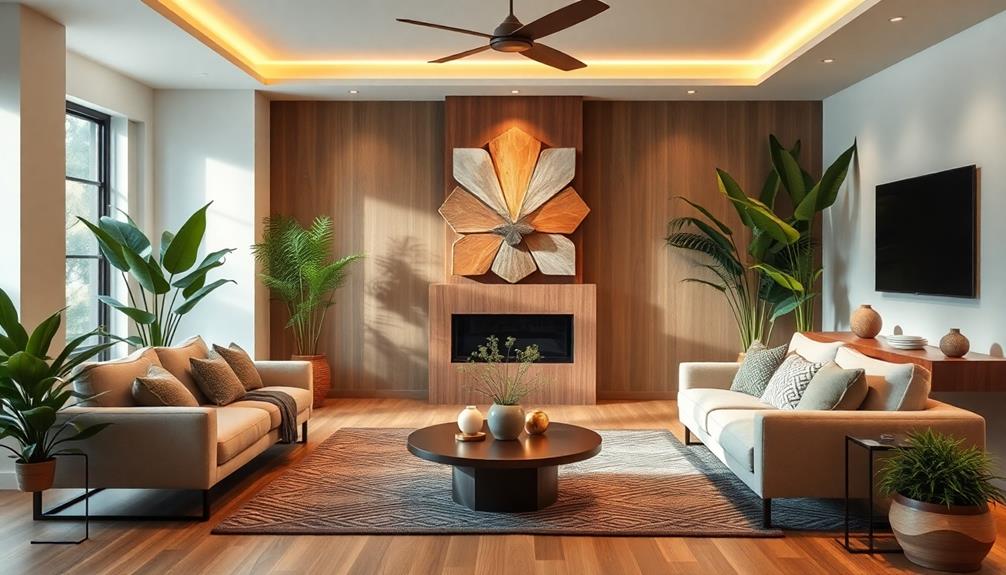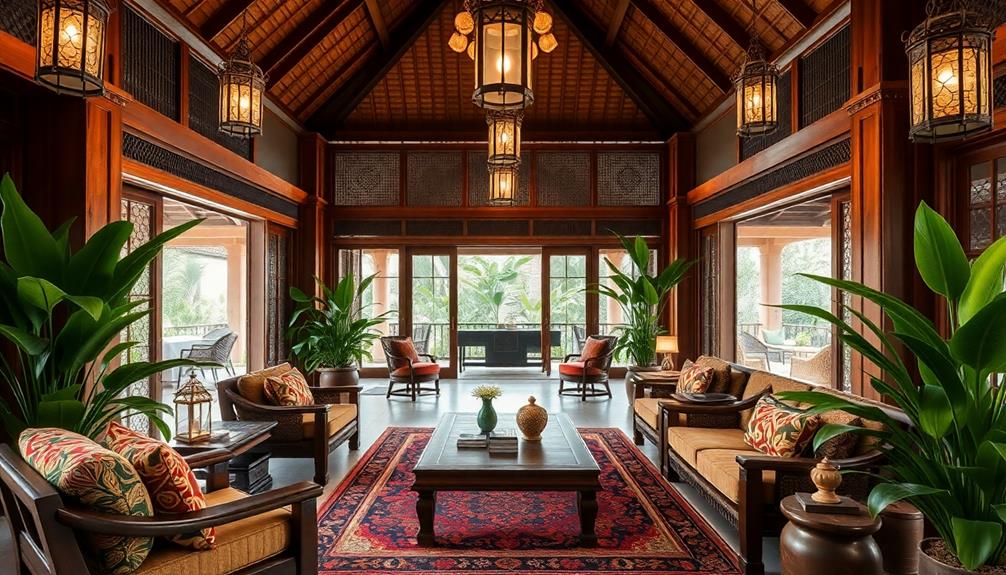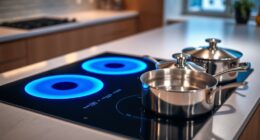Mixing and matching interior decor styles can truly showcase your personality. Start with a neutral base color to keep things cohesive. Then, select two accent colors that reflect your vibe. Incorporate vintage pieces for charm, but contrast them with modern elements to create interest. Remember to maintain balance in sizes and shapes of furniture. Don't shy away from personal touches—designate spaces that reflect your style while complementing the overall theme. Avoid matching sets; instead, choose unique statement items. Keep exploring fresh ideas and techniques to elevate your decor game, and there's plenty more you can discover! Seek inspiration from various sources such as magazines, social media, and interior design blogs to find the perfect interior decor that speaks to you. Experiment with different textures and materials to add depth and character to your space. Embrace the process of creating a home that not only looks beautiful but also feels authentically you. Remember, the perfect interior decor is one that reflects your individuality and brings you joy every time you step into the room.
Key Takeaways
- Establish a shared vision among all parties involved to guide the blending of different styles effectively.
- Start with a neutral color foundation and create a cohesive color palette with accent colors to enhance versatility.
- Integrate vintage pieces with modern decor for visual contrast while ensuring they complement each other in size and style.
- Designate personal spaces that reflect individual style while maintaining harmony with shared areas in the home.
- Avoid matching sets by selecting statement pieces from diverse collections to foster a dynamic and curated aesthetic.
Preparing for Style Blending

When you're gearing up to blend different interior decor styles, it's essential to involve everyone in the design process. This inclusion enhances investment and understanding, making the shift smoother. Open communication about personal likes and dislikes can help alleviate potential conflicts.
It's all about establishing a shared vision for your living space. Incorporating elements like Indonesian decorative pillows can add vibrant colors and cultural significance to your design. As you start mixing different styles, compromise is key. Collaborating with each party's preferences can lead to unique design opportunities that satisfy everyone involved.
Remember, it's not just about aesthetics; functional choices are equally important. Comfortable seating can adhere to your aesthetic preferences while ensuring everyone feels at home in your shared living area.
Focusing on a neutral foundation can also provide versatility, serving as common ground for blending styles effectively. This allows for the integration of various elements without overwhelming the space.
Key Elements for Cohesion

Achieving cohesion in a mixed style space requires a thoughtful approach to key design elements. Start with a neutral foundation color, like warm neutrals or dark tones, allowing versatility across multiple styles. Then, create a methodical color palette by selecting two neutral shades and two accent colors. This helps maintain a unified look while preventing visual overwhelm.
To emphasize balance, guarantee that furniture pieces of varying styles complement one another in size. This prevents one style from dominating the space. Additionally, repetition of shapes and patterns throughout your decor fosters a cohesive visual flow, connecting different styles seamlessly.
Consider the following table to guide your choices:
| Key Element | Importance |
|---|---|
| Color Palette | Creates visual harmony |
| Furniture Scale | Balances diverse styles |
| Repetition | Establishes a unified feel |
| Blank Space | Enhances visual appeal |
Incorporating blank wall and floor space into your design allows breathing room, preventing overcrowding while showcasing your eclectic mix of styles. By focusing on these key elements, you'll achieve the desired cohesion in your beautifully blended space.
Integrating Vintage Furniture
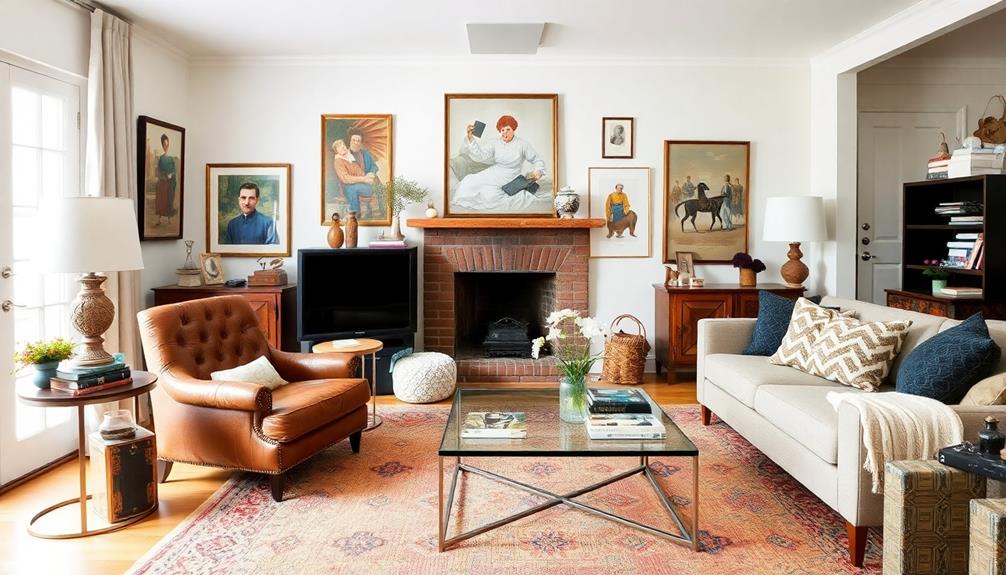
Integrating vintage furniture can bring a unique charm to your modern space.
By blending in vintage pieces with coastal color palettes and natural materials, you can create a harmonious and inviting atmosphere.
You can refresh old pieces with new paint or upholstery, making them stand out while still telling a story.
Refreshing Old Pieces
Revitalizing old pieces can transform your space and add character to your decor. When renewing old pieces, consider applying paint or new finishes to align them with your modern aesthetic. This simple update can breathe new life into vintage furniture, making it feel fresh and relevant in your home.
To enhance your decor even further, consider incorporating unique elements such as a Face Indonesian Decor Mask that represents rich cultural heritage, adding an intriguing focal point to your space.
To achieve an eclectic style, contrast vintage items with contemporary elements. For instance, vintage light fixtures can serve as eye-catching accents, enhancing the overall aesthetic of your modern space while adding unique historical significance.
Choose vintage pieces that share common colors or materials with your current decor to create a cohesive look throughout the room.
It's wise to avoid overly trendy vintage items that might quickly go out of style. Instead, focus on timeless designs that can adapt alongside future decor changes.
Vintage as Focal Points
Incorporating vintage furniture can elevate your interior decor by providing striking focal points that draw the eye and spark conversation. These unique pieces not only carry history but also add depth to your contemporary designs.
When selecting vintage items, aim for contrasts with modern elements; for instance, a vintage leather armchair can beautifully complement a sleek, minimalist sofa, creating a visual dialogue in your space. Additionally, consider integrating natural materials like wood and stone, which are prevalent in Balinese design, to enhance the warmth and texture of your vintage pieces.
Be mindful of scale when integrating vintage furniture. Oversized pieces can anchor a room, while smaller items add subtle charm without overwhelming your decor. Revitalizing your vintage finds with new paint or upholstery can help them blend seamlessly with your current color palette, showcasing their original character while keeping the overall aesthetic cohesive.
Don't forget about vintage accessories! Incorporating items like light fixtures or decorative accents can enhance your theme and tie the room together. These smaller elements emphasize the vintage aesthetic without overpowering other styles, allowing you to create a balanced and inviting atmosphere.
Blending Vintage With Modern
Mixing vintage furniture with modern decor creates an alluring visual contrast that enriches any space. By integrating vintage pieces, you introduce unique artistry and craftsmanship that beautifully contrasts with sleek modern style.
Incorporating elements of traditional Indonesian style home decor can further enhance this aesthetic by using natural materials and intricate carvings to create depth and warmth. Look for striking focal points, like a weathered wooden table or a tufted velvet chair, to enhance your decor's visual interest.
To create cohesion, consider revitalizing vintage furniture with a new coat of paint or updated upholstery. This can help harmonize these pieces within your contemporary environment. Vintage light fixtures, like chandeliers or sconces, add character and warmth while complementing minimalist furniture or clean lines.
When mixing and matching, don't overlook the importance of texture. Incorporating various textures from vintage items alongside modern materials creates a layered look that draws the eye.
Additionally, research the history and style of your vintage furniture. Understanding their background can enrich the storytelling aspect of your decor, making the space feel more intentional.
Ultimately, blending vintage and modern styles invites creativity into your home. Embrace this fusion to transform your space into an elegant, personalized retreat that reflects your unique taste.
Creating Personal Spaces

Creating personal spaces in your home lets you express your individual style without clashing with shared decor. By designating specific areas like a home office or reading nook, you can showcase your unique tastes while still maintaining overall harmony.
Consider incorporating elements of Scandinavian charm to enhance warmth and functionality in these spaces. Embrace the opportunity to mix and match styles in these areas, making them truly your own.
Designate Personal Areas
Designating personal areas in your home allows you to showcase your unique style without overwhelming shared spaces. By creating specific rooms or corners for individual expression, you can freely incorporate your personal style while maintaining harmony in the rest of the home.
You might consider integrating elements from Southeast Asia decor to infuse vibrant colors and intricate patterns that reflect your personality. Here are a few ideas to get you started:
- Create a cozy reading nook: Use a mix of furniture styles—perhaps a Victorian armchair paired with a modern floor lamp—to craft an inviting space.
- Display sentimental collections: Showcase your cherished items or memorabilia in a way that complements the overall design, making them focal points without clashing with shared decor.
- Experiment with vignettes: Combine two different styles, like mid-century modern and bohemian, to create engaging visual displays that reflect your personality.
Express Individual Style
Your home should be a reflection of who you are, and carving out personal spaces is a fantastic way to express your individual style. Start by designating specific rooms or areas where you can showcase your unique taste without disrupting shared spaces.
In these personal zones, mix different design styles to create smaller vignettes. For example, pairing mid-century modern pieces with Victorian accents can result in a striking visual contrast that captures your essence. Consider integrating traditional artistry through Indonesian decor masks, as they can add a vibrant touch and tell stories of local cultures.
Encourage your creativity by incorporating your favorite colors, patterns, and textures that resonate emotionally with you. This is your space, so let it tell your story!
Open communication about likes and dislikes is essential, especially in shared environments, to foster understanding and collaboration while creating these personal havens.
Lastly, while you're expressing individual style, maintain a cohesive overall aesthetic. Use common elements like color or texture to tie your personal spaces back to the broader design theme of your home.
This way, you can enjoy the beauty of mixing different styles while ensuring harmony throughout your living space. Embrace your individuality and let it shine in each corner of your home!
Adapting to Design Trends
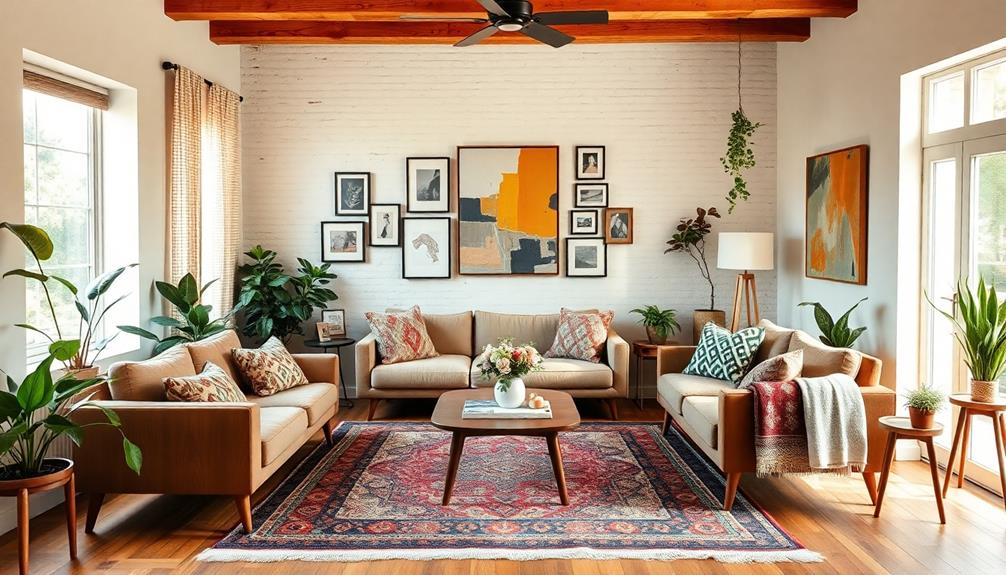
Staying on top of design trends can breathe new life into your home, allowing you to blend contemporary styles with your unique tastes. By regularly evaluating these trends, you can identify fresh ideas while incorporating your personal preferences.
For example, incorporating sustainable practices in design not only aligns with current trends but also enhances the overall aesthetic of your space. Mixing nostalgic elements with modern style creates a balance that guarantees longevity in your decor.
To effectively adapt to design trends, consider these tips:
- Embrace the rule of thirds to create balanced and engaging layouts.
- Experiment with varied textures and colors to elevate your color scheme and enhance visual interest.
- Integrate trendy items alongside timeless decor for a cohesive yet dynamic blend.
Common Color Palette Strategies
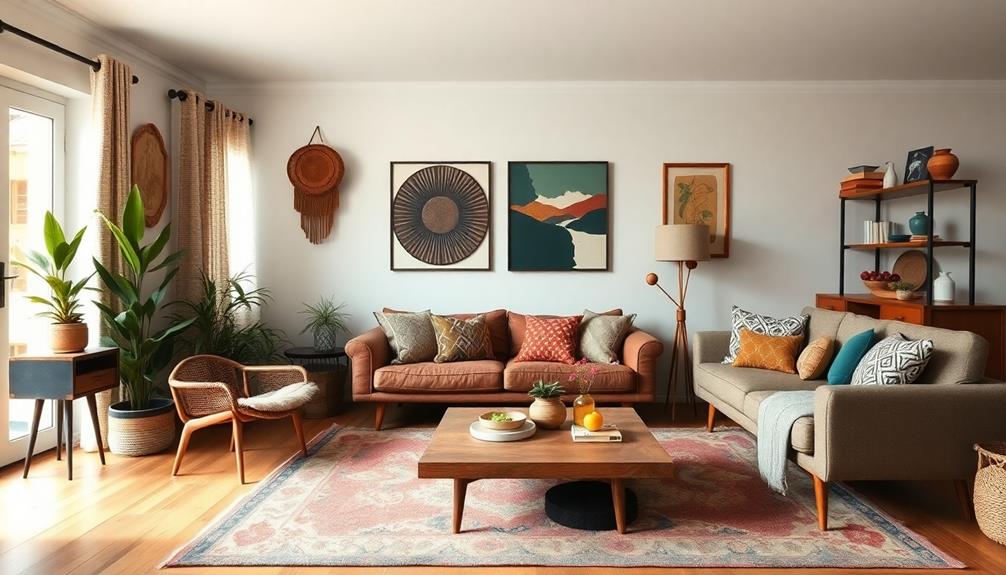
Creating a cohesive color palette can transform your space, making it feel more intentional and inviting. Start by selecting two neutral shades and two accent colors. This strategy lays a harmonious foundation for your decor and guarantees that your styles blend seamlessly.
Using a unifying color scheme throughout your home prevents visual overwhelm and maintains a balanced aesthetic. Incorporate your accent colors through decorative elements like artwork, pillows, and accessories, adding personality while guaranteeing consistency. Focus on a statement piece in each room that draws attention and reinforces your chosen color palette.
Here's a quick reference table to help you plan your color strategy:
| Neutral Shades | Accent Colors |
|---|---|
| Soft Beige | Deep Teal |
| Light Gray | Burnt Orange |
| Warm White | Rich Burgundy |
| Cool Taupe | Vibrant Mustard |
Regularly assess how your color choices resonate with each other as you blend styles. This way, you'll guarantee they support and enrich the diverse elements within your decor, ultimately enhancing the overall design cohesion.
Avoiding Matching Sets

Many people overlook the impact of matching sets in their decor, often leading to a stifled and monotonous aesthetic. Traditional design emphasizes historical accuracy and regional styles, which can be a great inspiration when blending elements.
Instead of sticking to uniform collections, you should embrace a mix of styles and textures that create visual interest and a welcoming environment. By doing so, you can enhance your space with layers that feel curated and personal.
Consider these tips to avoid matching sets:
- Choose statement pieces: Select standout items from different collections to serve as focal points in your room.
- Incorporate various styles: Blend modern, traditional style, and even Coastal or Transitional elements for a more dynamic look, such as incorporating elements from Native Houses in Indonesia that reflect local culture and sustainability.
- Utilize customizable options: Take advantage of Universal Furniture's options, like over 400 fabric choices and 50 leather options, to create a unique aesthetic.
Mixing different styles allows you to break free from the impersonal feel of matching sets. Instead, you'll foster a space that resonates with creativity and individuality, making your home truly yours.
Embrace the art of mixing, and watch your decor evolve into something vibrant and engaging!
Expert Design Resources

Expert design resources can be invaluable when it comes to transforming your space. With personalized design guidance from professionals, you can explore various styles and receive tailored advice that suits your unique needs. One great option is Havenly, which offers a user-friendly app that provides access to design tools and resources. This makes it easier for you to visualize and execute your design ideas effectively.
Additionally, Havenly's blog features categories like Home Tours and Design 101, filled with in-depth articles and inspiration on a wide array of interior design topics. This resource is perfect for anyone looking to deepen their understanding of different styles.
To further enhance your experience, you can take a style quiz that matches you with design experts, ensuring their advice aligns with your preferences and aesthetics.
With access to a variety of design styles and preferences through Havenly's extensive resources, you'll be empowered to make informed design decisions. Embrace these expert design resources to create a cohesive, personalized space that reflects your individuality while masterfully mixing and matching different decor styles.
Frequently Asked Questions
What Interior Design Styles Go Well Together?
You can beautifully blend modern and traditional styles for warmth, or try bohemian with mid-century modern for an eclectic vibe. Farmhouse and coastal create a relaxed space, while classic and luxe adds elegance. Explore your favorites!
How Do You Mix Different Styles in a Design?
Imagine your favorite playlist, blending genres seamlessly. To mix different styles in design, start with a cohesive color palette, choose an anchor piece, and embrace contrasts. Select personal favorites that resonate, creating harmony and balance.
How Do You Mix and Match Décor?
To mix and match décor, start with a unifying color palette. Incorporate varied textures and patterns, choose a focal point, limit accent pieces, and select personal favorites that resonate with you for a unique space.
Can You Have Different Décor Styles in Each Room?
Yes, you can definitely have different decor styles in each room! Just keep a cohesive color palette and common design elements. This way, you'll create a harmonious flow throughout your home while showcasing your unique preferences.
Conclusion
Mixing and matching interior decor styles can transform your space into a unique reflection of your personality. Did you know that 80% of people feel more relaxed in a home that showcases personal style? By blending different elements, integrating vintage pieces, and using cohesive color palettes, you'll create an inviting atmosphere. Remember, it's all about expressing yourself, so don't shy away from experimenting. Embrace the unexpected, and your home will truly stand out!

